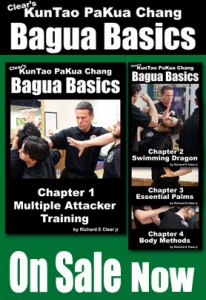This is lesson 5 in our free online Bagua training.
Transcript:
Bagua has different methods for how it engages or doesn’t engage an opponent. So I’m going to give you some insight into that.
As they bring a punch right down the line, one method is to get out of the way and keep walking, get off the line and keep walking. If you have been looking at other Bagua at all, ever, anywhere where they’re using it some, ideally you’ve seen that a bit.
Softly get out of the way
So that one is what I will call a very soft, to the other person, you’re trying to get them to hit empty air and not even necessarily feel you at all where you’ve made that connection but the connection is light and not stationary, it doesn’t stay put.
Although you will see where they punch and you cut across and they come and you’ll cut across and they come and you’re interacting and being soft until you get into a place where you actually land something.
Let them run into some hard
There is also this idea, I want to get out from in front of it, but I actually want them to feel like they ran into something hard.
This is one of the trickiest things that I try to teach regularly to really convey to people. Because for you, on your side it should feel like I hit air or almost air. for them it should feel like they ran into the wall and this should happen at the same time.
Use the Wedge
How do you get that, how does that happen, how do I get it so that he runs into something hard and I felt soft?
One of the ways I’ve seen it taught, and this is from Dr. John Painter, was what he calls the wedge and with the wedge he’s doing it here and the person comes and he starts coming this way and then it rolls a bit and cuts in so that you’re really rolling across it but they’re hitting into something hard that they can’t navigate through so they’re hitting it hard while you’re sort of coming around them.
So you can start it like that for simplicity. Make sure that it’s not grrr and I roll while keeping in there and I roll it and stay on it so that he feels all that power and it knocks him out of the way and yet I’m getting very little off of that because of the way that I’m wedging into it.
Use the forearms
I’m going to step it up a notch and do it slightly more sophisticated but also something a little more powerful. So what we’re going to use is the whole back of the forearm which we call a bone shield. You’ll notice that if my arm is in front, this part is leading, whether I’m going back or forth, up or down.
It is a little bit rounded because I want all that bony edge right there to be what they’re getting.
It should be that you can tell it’s a hard hit but the back of your forearm is going, “I’m not really feeling a whole lot but it’s good. It’s a rake or a brush, not your wrist but your forearm, back and forth, up and down.
It’s like they’re running into the wall but I’m hanging out here.


You must be logged in to post a comment.